Stuck, I knew a trip to New York was essential for my search. Two months later, in September, I flew up from Florida and spent almost a month in pursuit of my father’s life story in Sing Sing.
In Manhattan, I went to the New York City Municipal Archives and looked through the microfilmed Magistrate’s Court Minutes for the twenties. Though Leonora Gidlund at the archive had searched earlier without success, I had to study them myself to be certain my father’s case was not there. It took two full days and I found nothing, no criminal trial of Harry N. Gold for armed robbery.
A day later, I took the train to White Plains to look in the records of the County Clerk’s Office.
From Sing Sing to Ossinsing to Ossining
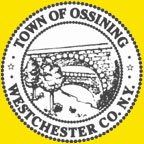
A brief history of the Town of Ossining by Town Historian Roberta Arminio can be accessed on the town's official web site by clicking the above image of the town seal.
|
|
White Plains is the County Seat and largest city of Westchester County, in which the town of Ossining is located. It occurred to me that my father might have committed his last robbery nearer home, in White Plains, where he was arrested and convicted for the crime. In the Record Room of the County Clerk’s Office, I learned the criminal trial book for the twenties was missing and had not been seen for several years.
After my return to New York City, I went to the Lloyd Sealy
Library at the John Jay College of Criminal Justice. I had made earlier arrangements to look at the Lewis Lawes Papers. Lawes, a recognized prison reformer and vocal critic of capital punishment, was warden of Sing Sing (1920-1941) and wrote two well-known books about his reform efforts and experiences -- Life and Death in Sing Sing and 20,000 Years in Sing Sing.
I spent most of a day at the Lloyd Sealy Library in the hope of finding information about the exhibition games played between the inmate team and the Giants and Yankees. I also was in search of old issues of the Sing Sing News, an inmate newspaper printed in the twenties. There was an outside chance that I might find box scores for the exhibition games with Dad’s name listed as one of the players on the prison team.
Lloyd Sealy Library is named in memory
of police professional & scholar.
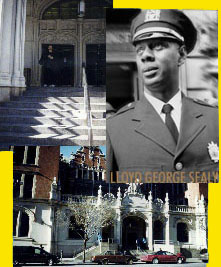
The excellent resources of the Lloyd Sealy Library at John Jay College of Criminal Justice include the Papers of Lewis E. Lawes in the library's Special Collections (Boxes X101 - 13). Lawes was Sing Sing warden from 1920 to 1941. Click on the image above from the Lloyd Sealy Library home page to access the site.
|
|
No newspapers were in the library and I found nothing except a couple of old black and white photographs of the inmate baseball team from what looked to be the twenties. The photos were undated and lacked the players’ names. One of them included a man who had a resemblance to my father, but after studying the photograph with a magnifying glass, I doubted the player was my dad. I concluded the resemblance I saw was the result of a wish rather than reality
The other team photo, which included Warden Lewis Lawes and his young daughter, Joan Marie, also appeared to be taken in the twenties. Near the end of my research at the Lloyd Sealy Library, I quickly looked the photo over and copied it along with the first picture I had found. The copies were of poor quality, but provided the only visible evidence of the prison players of that time. Sing Sing’s inmate team was called the Mutual Welfare League Team.
Scrutinizing the second photo that evening, I was startled to
see a baseball player who looked a lot like my father. The man in this picture has his physical likeness, not the vague resemblance of the man in the first photograph I found. He is sitting at the end of a row of players and the warden’s daughter, Joan Marie, is seated in the middle of the same row. She has the three-lettered MWL (Mutual Welfare League) emblem on her shirt.
Ossining Historical Society Museum.
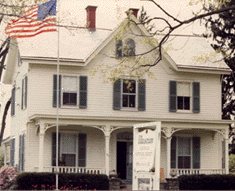
Ossining Historical Society Museum at 196 Croton Ave., founded in 1931, is devoted to the history of Ossining and vicinity, including Sing Sing Prison. Its web site includes excellent old prison photos. Admission free. Hours: Sunday - Thurssday. 1 to 4 p.m.; daily by appointment (914) 762-5327. Roberta Y. Arminio is executive director.
|
|
The old black and white photo cannot be considered conclusive evidence that my father was on the prison team, but it is at least suggestive. I used a magnifying glass to examine him closely and his facial features, especially his large ears and long nose, look exactly like those I have seen in pictures of my dad when he was a younger man. The way he sits, leaning slightly forward, and clasps his hands together likewise seems characteristic of my father. I recall him sitting in that pose, his face animated as he explained something to me.
His slender build also looks like my dad’s. But I would be more convinced the player in the photograph was my father if his distinctive curly hair could be seen and not covered by a baseball cap. A cigarette cupped in his right hand also would have helped me be more certain.
Sing Sing Superintendent Brian Fischer
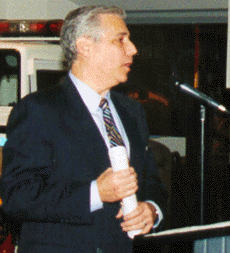
Brian Fischer addresses a meeting of the NYCHS in the Police Museum Feb. 16, 2000. He is New York Correction History Society Vice President.
|
|
A day later, taking a morning train on the New York Central’s
Hudson Line, I went “up the river” to Ossining and visited the old prison now called the Sing Sing Correctional Facility. Invited by Superintendent Brian Fischer, I was given a personal tour of the prison, including the site, where the inmates once played baseball against the New York Giants and Yankees, seventy years ago.
From the Sing Sing staff, I was disappointed to discover that the inmate case files for much of the early twentieth century had been consumed in a 1984 fire that burned the old cell block, where they were stored along with flammable paint supplies. No record of my father’s life and times in Sing Sing existed; there was not one bit of evidence indicating he had ever been in the prison.
In the Deputy Superintendent’s office, there was a drawer in his desk, containing old sports materials and pictures, but I was not permitted to examine them. Sometime later, he did send me a three-page history of inmate baseball played at Sing Sing.
But, by the time I received the history, I had already been in contact with its author, Brant L. Kehn, former First Deputy Superintendent of Sing Sing. Kehn, who recently retired as Superintendent of the Fulton Correctional Facility in the Bronx, not only mailed me his history of Sing Sing baseball, but pointed me toward several other research sites, most particularly the Ossining Historical Society.
Warmly welcomed by Director Roberta Arminio, I spent two days at the Historical Society looking through its Sing Sing materials.
Former Sing Sing Deputy Superintendent Brant Kehn.
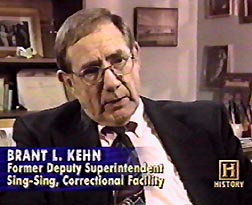
New York Correction History Society Executive Committee member-at-large Brant Kehn was among NYCHS officers, founders and members who participated in The History Channel's Modern Marvels: Prisons. Click the above image to access a presentation on NYCHS participation in the documentary.
|
|
Disappointed to find nothing on my father in the society’s prison collection, I hoped, at least, to see an account of his arrest in an old newspaper. The Historical Society owns a microfilmed copy of Ossining’s Citizen Sentinel beginning in 1925 and running all the way through the last century. Surely, I thought, somewhere on some page in an early issue of the Citizen Sentinel, I would find one story detailing Dad’s arrest, trial or conviction.
I spent hours reading newspaper microfilm and found nothing.
There were a number of Ossining men arrested and tried for crimes in 1925, 1926 and early 1927, but no Harry N. Gold. Such news was front-page stuff, whether the crimes were committed locally or in the county or New York City. After searching without any success through the first half of 1927, I ceased reading microfilm because it was obvious that a five-year sentence in Sing Sing would extend well beyond the time of my birth in 1932.
I was baffled, to say the least, when I left Ossining. Why was no mention made of my father’s arrest in the Citizen Sentinel ? Why was there nothing about his crime in the New York Times or the Municipal Archives? Why was there no record of him at Sing Sing?
It was as if my father never went to prison. I knew better, of course. His incarceration was well known to relatives on both
maternal and paternal sides of my extended family. Once I brought up the subject to them, they were quite willing to talk about what had been a whispered family scandal. My cousin Marian remembers a car ride home from school when she was fifteen, with my father and a man he identified as someone who had been in Sing Sing with him. And, Dad told me about his time in prison, albeit reluctantly.
Sing Sing Warden & Principal Keeper
during the 1920s.
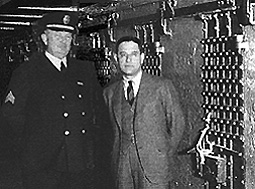
When Harry N. Gold arrived as an inmate at Sing Sing, prison reformer Lewis E. Lawes had already been warden there five years. Lawes, in civilian clothes right, is shown in the above image with James Connaughton, in uniform left, who was
Principal Keeper when Lawes became warden in 1920.
The photo is among scores of Sing Sing images that can be seen in this web site's presentation of text and images from Guy Cheli's Images of America: Sing Sing Prison. See link at bottom of all the main right side frames in this Searching Sing Sing for My Father presentation.
|
|
As my time in New York was coming to a close, I went to see my oldest friend in Oneonta, a small college town two hours from Albany by automobile.
I had planned to visit the state archives nearby, but, without knowledge of the date of my dad’s conviction,
there was no point to the trip.
An extended e-mail correspondence with Jim Folts, Head of Reference Services at the Albany archives, made it clear that an appearance at the archive without that date in mind would be a futile effort.
At breakfast in Oneonta, the next morning, my friend, Mike Siegel, another mutual friend, Walter Vom Saal and I discussed my research problems. Walter then made a suggestion that would lead me ultimately to the information I had been seeking. His advice was to inquire about the existence of Sing Sing parole records at the State Archives, an approach I had not considered.
That same day, I e-mailed Jim Folts and inquired about the possible existence of parole records for Sing Sing prison in the twenties. I told him I had exhausted all available sources, which should have yielded my father’s date of conviction, and asked him for suggestions. His reply stated there were no Sing Sing parole records in the state archive and said he had “no other suggestions on how to locate the Sing Sing admission date.”
About to throw his reply in the wastebasket, I read the next sentence in his note. “However, you are welcome to search through the Sing Sing Admissions Registers if you are ever in Albany.” At 6:00 a.m., the next morning, I was on my way to Albany.

